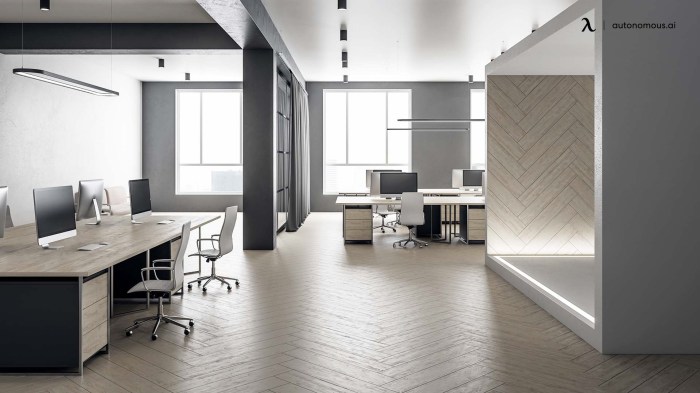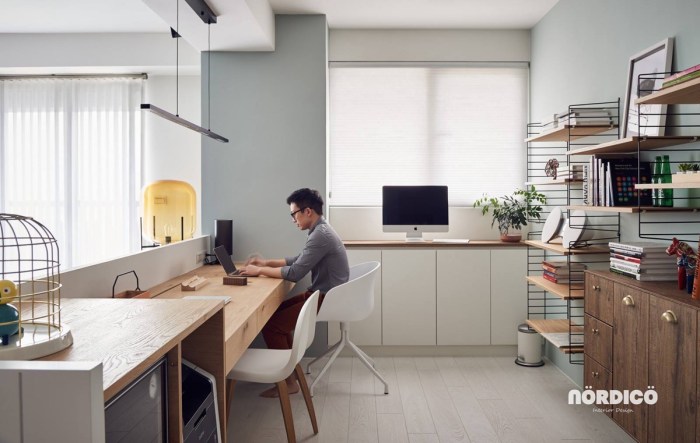
Embark on a journey through the realm of Minimalist Design for Workspaces, exploring how simplicity and functionality converge to create optimal work environments. As we delve into the key concepts and benefits, discover how this design philosophy fosters productivity and enhances focus in the workplace.
Unveil the essential elements and iconic designs that define a minimalist workspace, paving the way for a clutter-free and inspiring setting that promotes efficiency and creativity.
Minimalist Design for Workspaces
Minimalist design in workspaces focuses on simplicity, functionality, and decluttering to create a clean and organized environment that promotes productivity and creativity.
Benefits of Minimalist Workspaces
Minimalist workspaces offer several benefits for productivity:
- Reduced distractions: A clean and clutter-free workspace can help eliminate distractions and improve focus on tasks.
- Enhanced creativity: Minimalist design can stimulate creativity by providing a visually calming environment.
- Increased efficiency: With everything organized and easily accessible, tasks can be completed more efficiently.
- Improved mental clarity: A minimalist workspace can help clear the mind and reduce stress, leading to better decision-making.
Essential Elements in a Minimalist Workspace
Key elements to include in a minimalist workspace:
- Simple desk: Opt for a clean, uncluttered desk with essential items only.
- Neutral color scheme: Choose neutral colors like white, beige, or grey to create a calming atmosphere.
- Organizational tools: Use storage solutions like shelves, bins, and trays to keep items tidy and easily accessible.
- Minimal decor: Select a few meaningful decorations or plants to personalize the space without overwhelming it.
Influence of Minimalist Design on Concentration and Focus
Minimalist design can positively influence concentration and focus in work environments:
- Clear mind: A clutter-free space can help reduce mental clutter and improve concentration on tasks at hand.
- Enhanced focus: By eliminating distractions, minimalist design allows individuals to focus more effectively on their work.
- Promotes mindfulness: The simplicity of a minimalist workspace encourages mindfulness and intentionality in work habits.
Modern Classics

Modern classics in design refer to timeless pieces that have stood the test of time and continue to be relevant in contemporary settings. These pieces often blend traditional elements with modern aesthetics, creating a perfect balance between functionality and style.
Key characteristics of modern classic furniture include clean lines, simple forms, and understated elegance. These pieces are often made from high-quality materials such as wood, leather, and metal, showcasing craftsmanship and attention to detail.
Enhancing a Minimalist Workspace
Modern classic pieces can enhance a minimalist workspace by adding sophistication and refinement to the overall design. Their timeless appeal helps create a sense of harmony and balance in a clean, uncluttered environment.
- Iconic modern classic designs like the Eames Lounge Chair and Ottoman bring comfort and style to a minimalist workspace, serving as a focal point without overwhelming the space.
- The Barcelona Chair by Mies van der Rohe is another popular choice for workspaces, known for its sleek design and luxurious feel, adding a touch of elegance to a minimalist setting.
- The Nelson Platform Bench by George Nelson is a versatile piece that can be used as a coffee table, extra seating, or display surface, making it a practical and stylish addition to any minimalist workspace.
Modern Living

Minimalist design and modern living go hand in hand as they both prioritize simplicity, functionality, and a clutter-free environment. By embracing minimalist design principles, modern living spaces can create a sense of calm, openness, and efficiency.
Applying Minimalist Design Principles
- Focus on decluttering: Remove unnecessary items and only keep essentials to create a clean and organized space.
- Opt for neutral color palettes: Stick to simple colors like white, beige, or gray to maintain a sense of tranquility and cohesion.
- Utilize multipurpose furniture: Choose furniture pieces that serve more than one function to maximize space and reduce clutter.
- Embrace natural light: Allow plenty of natural light to enter the space to create a bright and airy atmosphere.
Examples of Minimalist Design in Modern Homes
- Incorporating sleek and simple furniture with clean lines in the living room to promote a sense of openness and minimalism.
- Utilizing hidden storage solutions such as built-in cabinets or under-bed storage to maintain a clutter-free environment.
- Creating a minimalist kitchen with streamlined countertops, minimalistic decor, and efficient storage options for a functional and stylish space.
- Designing a minimalist bedroom with a focus on comfort, simplicity, and relaxation by using a neutral color scheme and minimalistic furniture.
In conclusion, Minimalist Design for Workspaces offers a refreshing approach to work environments, blending modern classics and minimalist principles to cultivate a space that nurtures both productivity and well-being. Embrace the simplicity, embrace the focus, and embrace a new era of workspace design.
Essential Questionnaire
How does minimalist design impact productivity in workspaces?
Minimalist design reduces visual clutter, promotes organization, and creates a calm environment that can enhance focus and efficiency.
What are some key characteristics of modern classic furniture?
Modern classic furniture typically features timeless design elements, high-quality materials, and a perfect balance between form and function.





